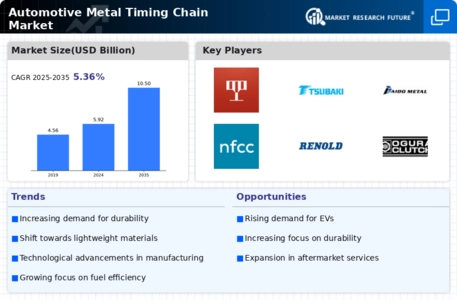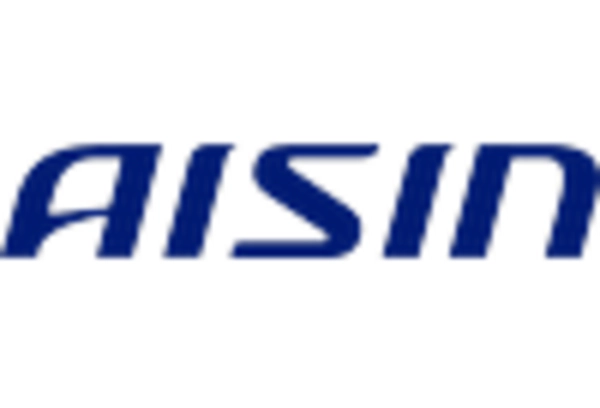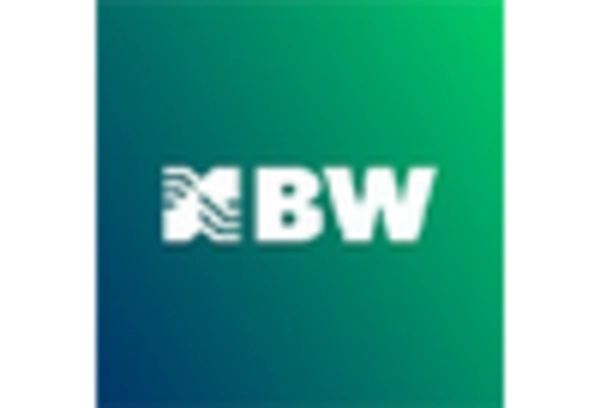Expansion of Aftermarket Services
The expansion of aftermarket services is a significant driver for the Automotive Metal Timing Chain Market. As vehicles age, the need for replacement parts, including timing chains, becomes increasingly critical. The aftermarket segment is projected to grow as consumers seek reliable and cost-effective solutions for vehicle maintenance. This trend is further supported by the rising number of vehicles on the road, which has increased the demand for replacement parts. Recent statistics indicate that the aftermarket for automotive components is expected to reach USD 500 billion by 2027. Consequently, the Automotive Metal Timing Chain Market stands to benefit from this growing segment, as more consumers opt for aftermarket solutions to extend the lifespan of their vehicles.
Rising Demand for Fuel Efficiency
The Automotive Metal Timing Chain Market is experiencing a notable increase in demand driven by the automotive sector's focus on fuel efficiency. As manufacturers strive to meet stringent emissions regulations, the integration of advanced timing chains has become essential. These components contribute to improved engine performance and reduced fuel consumption, aligning with consumer preferences for economical vehicles. In recent years, the market has seen a shift towards lightweight materials and innovative designs that enhance the efficiency of timing chains. This trend is expected to continue, with projections indicating a compound annual growth rate of approximately 5% over the next five years. Consequently, the Automotive Metal Timing Chain Market is poised for growth as automakers prioritize fuel-efficient technologies.
Growth of Electric and Hybrid Vehicles
The Automotive Metal Timing Chain Market is also being shaped by the increasing prevalence of electric and hybrid vehicles. While these vehicles utilize different powertrains, the transition towards hybrid models often incorporates traditional internal combustion engines that still require timing chains. As the automotive landscape evolves, manufacturers are investing in hybrid technologies that necessitate the use of reliable timing chains to ensure optimal performance. The market for hybrid vehicles is expected to grow at a rate of 15% annually, which will subsequently drive demand for metal timing chains. This shift indicates that the Automotive Metal Timing Chain Market must adapt to the changing dynamics of vehicle propulsion systems.
Technological Innovations in Engine Design
Technological advancements in engine design are significantly influencing the Automotive Metal Timing Chain Market. The introduction of variable valve timing and turbocharging has necessitated the development of more sophisticated timing chains that can withstand higher stresses and temperatures. These innovations not only enhance engine performance but also improve overall vehicle reliability. As manufacturers adopt these advanced technologies, the demand for high-quality metal timing chains is expected to rise. Recent data suggests that the market for timing chains is projected to reach USD 1.2 billion by 2026, reflecting a growing recognition of the importance of durable and efficient components in modern engines. Thus, the Automotive Metal Timing Chain Market is likely to benefit from ongoing technological progress.
Regulatory Compliance and Emission Standards
Regulatory compliance and stringent emission standards are pivotal factors influencing the Automotive Metal Timing Chain Market. Governments worldwide are implementing stricter regulations to reduce vehicular emissions, compelling manufacturers to adopt advanced technologies that enhance engine efficiency. Timing chains play a crucial role in ensuring that engines operate within these regulatory frameworks. As a result, the demand for high-performance metal timing chains is likely to increase as automakers strive to meet these standards. The market is expected to witness a surge in demand, with estimates suggesting a growth rate of around 6% annually in response to regulatory pressures. Thus, the Automotive Metal Timing Chain Market is positioned to thrive amid evolving compliance requirements.


















Leave a Comment